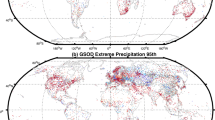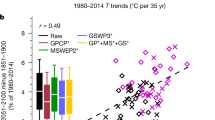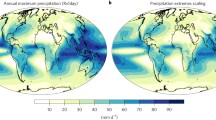Abstract
Increases in extreme precipitation greater than in the mean under increased greenhouse gases have been reported in many climate models both on global and regional scales. It has been proposed in a previous study that whereas global-mean precipitation change is primarily constrained by the global energy budget, the heaviest events can be expected when effectively all the moisture in a volume of air is precipitated out, suggesting the intensity of these events increases with availability of moisture, and significantly faster than the global mean. Thus under conditions of constant relative humidity one might expect the Clausius–Clapeyron relation to give a constraint on changes in the uppermost quantiles of precipitation distributions. This study examines if the phenomenon manifests on regional and seasonal scales also. Zonal analysis of daily precipitation in the HadCM3 model under a transient CO2 forcing scenario shows increased extreme precipitation in the tropics accompanied by increased drying at lower percentiles. At mid- to high-latitudes there is increased precipitation over all percentiles. The greatest agreement with Clausius–Clapeyron predicted change occurs at mid-latitudes. This pattern is consistent with other climate model projections, and suggests that regions in which the nature of the ambient flows change little give the greatest agreement with Clausius–Clapeyron prediction. This is borne out by repeating the analyses at gridbox level and over season. Furthermore, it is found that Clausius–Clapeyron predicted change in extreme precipitation is a better predictor than directly using the change in mean precipitation, particularly between 60°N and 60°S. This could explain why extreme precipitation changes may be more detectable then mean changes.







Similar content being viewed by others
References
Adler R, Huffman G, Chang A, Ferraro R, Xie P, Janowiak J, Rudolf B, Schneider U, Curtis S, Bolvin D, Gruber A, Susskind J, Arkin P, Nelkin E (2003) The version-2 global precipitation climatology project (GPCP) monthly precipitation analysis (1979-present). J Hydrometeorol 4:1147–1167
Allen M, Ingram W (2002) Constraints on future changes in climate and the hydrologic cycle. Nature 419:224–232
Betts A, Jakob C (2002) Evaluation of the diurnal cycle of precipitation, surface thermodynamics, and surface fluxes in the ECMWF model using LBA data. J Geophys Res 107:8045
Boer G (1993) Climate change and the regulation of the surface moisture and energy budgets. Clim Dyn 8:225–239
Collins M, Booth B, Harris G, Murphy J, Sexton D, Webb M (2006) Towards quantifying uncertainty in transient climate change. Clim Dyn (in press)
Cubasch U, Meehl GA (2001) Projections of future climate change. In: Houghton JT et al (eds) Climate change 2001, The scientific basis, chap. 9. Cambridge University Press, Cambridge, pp 527–582
Dai A, Trenberth K (2004) The diurnal cycle and its depiction in the community climate system model. J Clim 17:930–951
Dai A, Giorgi F, Trenberth K (1999) Observed and model-simulated diurnal cycles of precipitation over the contiguous United States. J Geophys Res 104:6377–6402
Easterling D, Evans J, Groisman P, Karl TR, Kunkel K, Ambenje P (2000) Observed variability and trends in extreme climatic events: a brief review. Bull Am Meteor Soc 81:417–426
Emori S, Brown S (2005) Dynamic and thermodynamic changes in mean and extreme precipitation under changed climate. Geophys Res Lett 32:L17 706
Emori S, Hasegawa A, Suzuki T, Dairaku K (2005) Validation, parameterization dependence, and future projection of daily precipitation simulated with a high-resolution atmospheric gcm. Geophys Res Lett 32:L06708
Folland CK, Karl TR (2001) Observed climate variability and change. In: Houghton JT et al (eds) Climate change 2001, The scientific basis, chap. 2, Cambridge University Press, Cambridge, pp 99–181
Frei C, Schär C, Lüthi D, Davies H (1998) Heavy precipitation processes in a warmer climate. Geophysical Res Lett25:1431–1434
Gordon C, Cooper C, Senior C, Banks H, Gregory J, Johns T, Mitchell J, Wood R (2000) The simulation of SST, sea ice extents and ocean heat transports in a version of the Hadley Centre coupled model without flux adjustments. Clim Dyn 16:147–168
Groisman P, Legates D (1994) The accuracy of United States precipitation data. Bull Am Meteor Soc 75:215–228
Groisman P, Karl T, Easterling D, Knight RW, Jamason P, Hennessy K, Suppiah R, Page C, Wibig J, Fortuniak K, Razuvaev V, Dougal A, Førland E, Zhai P (1999) Changes in the probability of heavy precipitation: important indicators of climatic change. Clim Change 42:243–283
Hegerl G, Zwiers F, Stott P, Kharin V (2004) Detectability of anthropogenic changes in annual temperature and precipitation extremes. J Clim 17:3683–3700
Held I, Soden B (2006) Robust responses of the hydrological cycle to global warming. J Clim (accepted)
Hennessy K, Gregory J, Mitchell J (1997) Changes in daily precipitation under enhanced greenhouse conditions. Clim Dyn 13:667–680
Hennessy K, Whetton P, Katzfety J, McGregor J, Jones R, Page C, Nguygen K (1998) Fine resolution climate change scenarios for New South Wales, annual report 1997–1998: research undertaken for the New South Wales environment protection authority. Available from CSIRO Private Bag 1, Mordialloc, Victoria 3195, Australia
Ingram W (2002) On the robustness of the water vapor feedback: Gcm vertical resolution and formulation. J Clim 15:1917–1921
IPCC (2002) Report on: Workshop on changes in extreme weather and climate events. Beijing, China, 11–13 June 2002. IPCC supporting material Available from http://www.ipcc.ch/pub/support.htm
Johns T, Gregory J, Ingram W, Johnson C, Jones A, Lowe J, Mitchell J, Roberts D, Sexton D, Stevenson D, Tett S, Woodage M (2003) Anthropogenic climate change for 1860 to 2100 simulated with the HadCM3 model under updated emissions scenarios. Clim Dyn 20:583–612
Karl T, Knight R (1998) Secular trends of precipitation amount, frequency and intensity in the USA. Bull Am Meteor Soc 79:231–242
Kharin V, Zwiers F (2000) Changes in the extremes in an ensemble of transient climate simulations with a coupled atmosphere-ocean GCM. J Clim 13:3760–3788
Kiktev D, Sexton D, Alexander L, Folland C (2003) Comparison of modeled and observed trends in indicies of daily climate extremes. J Clim 16:3560–3571
Knutson T, Tuleya R, Shen W, Ginis I (2001) Impact of CO2 induced warming on hurricane intensities as simulated in a hurricane model with ocean coupling. J Clim 14:2458–2468
Koster R, Dirmeyer P, Guo Z, Bonan G, Chan E, Cox P, Gordon C, Kanae S, Kowalczyk E, Lawrence D, Liu P, Lu CH, Malyshev S, McAvaney B, Mitchell K, Mocko D, Ok T, Oleson K, Pitman A, Sud Y, Taylor C, Verseghy D, Vasic R, Xue Y, Yamada T (2004) Regions of strong coupling between soil moisture and precipitation. Science 305:1138–1140
Lambert F, Stott P, Allen M, Palmer M (2004) Detection and attribution of changes in 20th century land precipitation. Geophys Res Lett 31:L10 203
Lambert F, Gillett N, Stone D, Huntingford C (2005) Attribution studies of observed land precipitation changes with nine coupled models. Geophys Res Lett 32:L18 704
Leggett J, Pepper WJ, Swart R (1992) Emissions scenarios for the IPCC: an update. In: Houghton JT et al (eds) Climate change 1992, the supplementary report to the IPCC scientific assessment, chap. 3, Cambridge University Press, Cambridge, pp 69–75
McAvaney B (2001) Model evaluation. In: Houghton JT et al (eds) Climate change 2001, the scientific basis, chap. 8. Cambridge University Press, Cambridge, pp 471–526
McGuffie K, Henderson-Sellers A, Holbrook N, Kothavala Z, Balachova O, Hoekstra J (1999) Assessing simulations of daily temperature and precipitation variability with global climate models for present and enhanced greenhouse climates. Int J Climatol 19:1–26
Meehl G, Boer G, Covey C, Latif M, Stouffer R (2000a) The coupled model intercomparison project (CMIP). Bull Am Meteor Soc 81:313–318
Meehl G, Zwiers F, Evans J, Knutson T, Mearns L, Whetton P (2000b) Trends in extreme weather and climate events: issues related to modelling extremes in projections of future climate change. Bull Am Meteor Soc 81:427–436
Meehl G, Arblaster J, Tebaldi C (2005) Understanding future patterns of increased precipitation intensity in climate model simulations. Geophys Res Lett 32:L18 719
Mitchell J, Wilson C, Cunnington W (1987) On CO2 climate sensitivity and model dependence of results. Q J R Mereorol Soc 113:293–322
Osborn T, Hulme M (1997) Development of a relationship between station and grid-box rainday frequencies for climate model evaluation. J Clim 10:1885–1908
Osborn T, Hulme M, Jones P, Basnett T (2000) Observed trends in the daily intensity of United Kingdom precipitation. Int J Climatol 20:347–364
Pope V, Gallani ML, Rowntree P, Stratton R (2000) The impact of new physical parameterizations in the Hadley Centre climate model: HadAM3. Clim Dyn 16:123–146
Räisänen J, Hansson U, Ullerstig A, Döscher R, Graham L, Jones C, Meier H, Samuelsson P, Willén U (2004) European climate in the late twenty-first century: regional simulations with two driving global models and two forcing secnarios. J Clim 22:13–31
Semenov V, Bengtsson L (2002) Secular trends in daily precipitation characteristics: greenhouse gas simulation with a coupled AOGCM. Clim Dyn 19(2):123–140
Smith R (1990) A scheme for predicting layer clouds and their water content in a general circulation model. Q J R Mereorol Soc 116:435–460
Suppiah R, Hennessy K (1998) Trends in total rainfall, heavy rain events and number of dry days in australia, 1910–1990. Int J Climatol 18:1141–1164
Trenberth K (1999a) Atmospheric moisture recycling: role of advection and local evaporation. J Clim 12:1368–1381
Trenberth K (1999b) Conceptual framework for changes of extremes of the hydrological cycle with climate change. Clim Change 42:327–339
Trenberth K, Dai A (2003) The changing character of precipitation. Bull Am Meteor Soc 84:1205–1217
Watterson I, Dix M (2003) Simulated changes due to global warming in daily precipitation means and extremes and their interpretation using the gamma distribution. J Geophys Res 108:4379
Wehner M (2004) Predicted 21st century changes in seasonal extreme precipitation events in the Parallel Climate Model. J Clim 17:4281–4290
Wilby R, Wigley T (2002) Future changes in the distribution of daily precipitation totals across the United States. Geophys Res Lett 29:391–394
Xie P, Arkin P (1997) Global precipitation: a 17-year monthly analysis based on gauge observations, satellite estimates and numerical model outputs. Bull Am Meteor Soc 78:2539–2558
Yin J (2005) A consistent poleward shift of the storm tracks in simulations of 21st century climate. Geophys Res Lett 32:L18 701
Acknowledgments
The authors especially wish to thank Jonathan Gregory for provision of data and assistance with analysis. We also thank him, along with William Ingram, for insightful discussion. Furthermore, we are grateful to the reviewers for helpful suggestions and Steve Jewson and Robert Muir-Wood for advice on interpretation of results. P.P. was supported by a CASE Award studentship from the UK Natural Environment Research Council with Risk Management Solutions Ltd. M.R.A. received support from the US NOAA/DoE International Detection and Attribution Group. D.A.S. was supported by the UK Department for Environment, Food, and Rural Affairs and a Wellcome Trust Showcase Award.
Author information
Authors and Affiliations
Corresponding author
Rights and permissions
About this article
Cite this article
Pall, P., Allen, M.R. & Stone, D.A. Testing the Clausius–Clapeyron constraint on changes in extreme precipitation under CO2 warming. Clim Dyn 28, 351–363 (2007). https://doi.org/10.1007/s00382-006-0180-2
Received:
Accepted:
Published:
Issue Date:
DOI: https://doi.org/10.1007/s00382-006-0180-2




